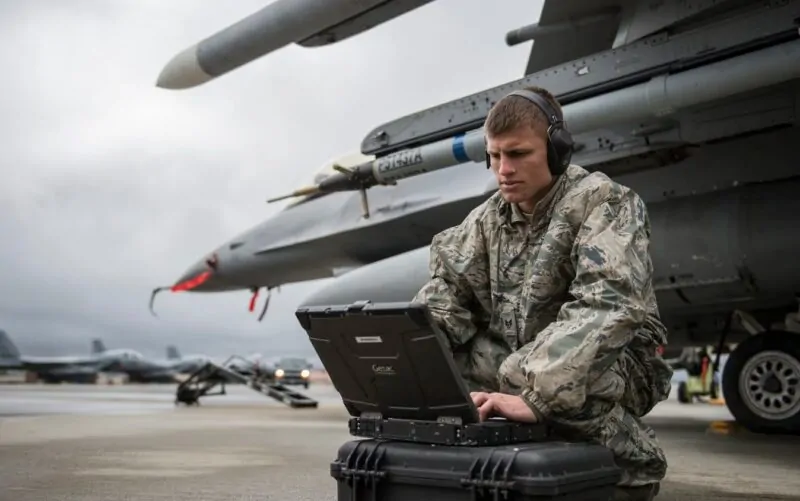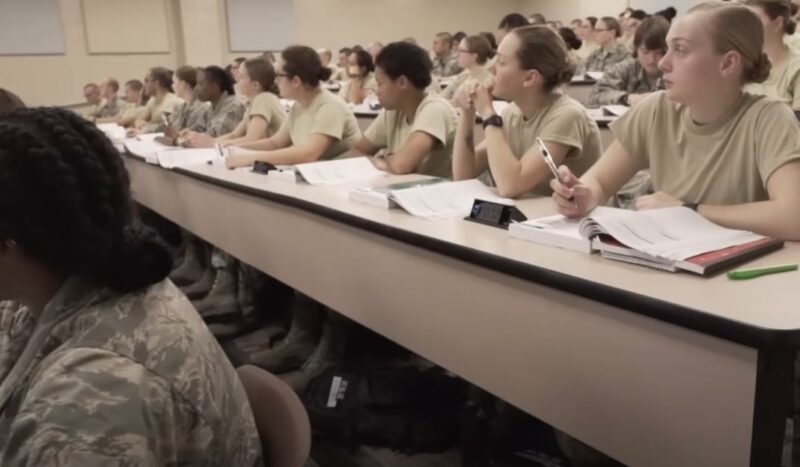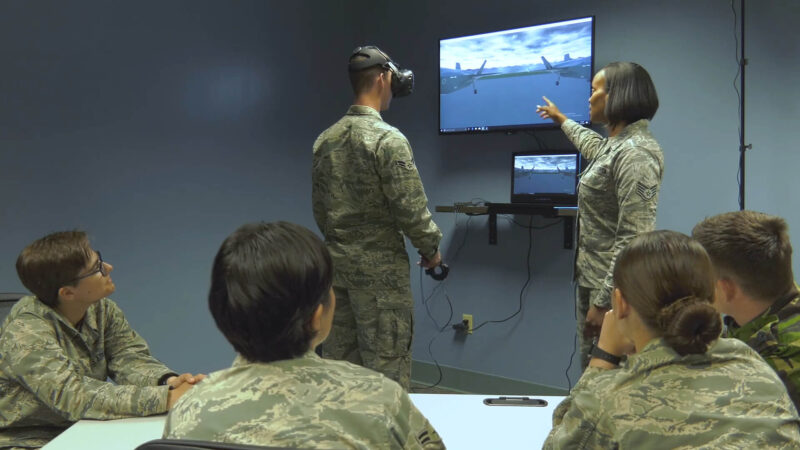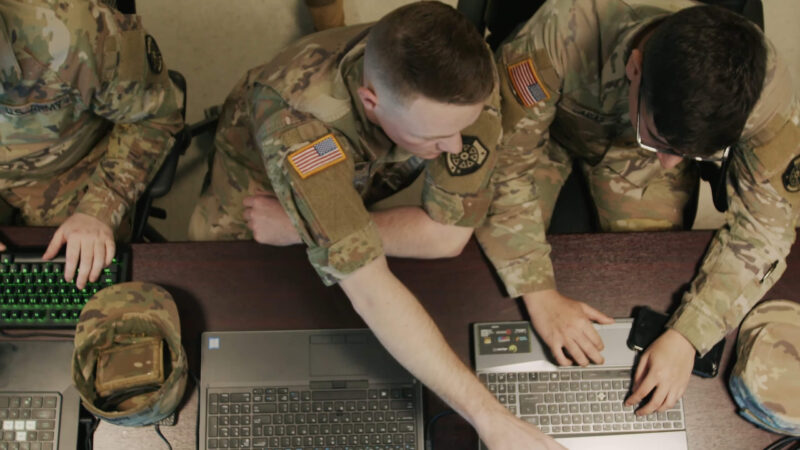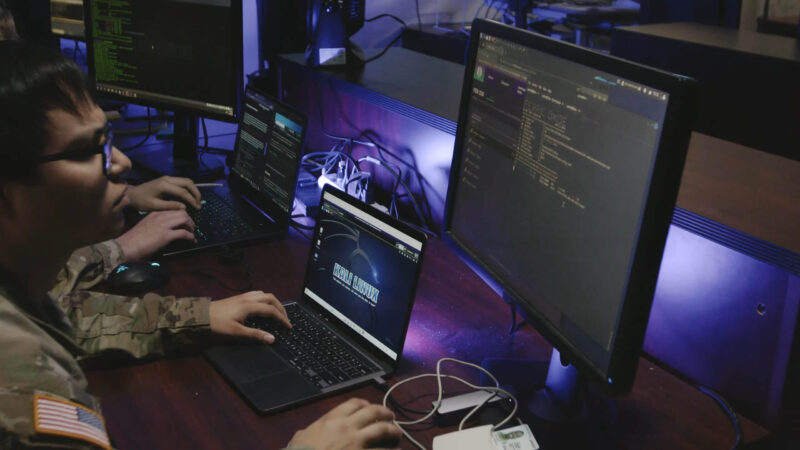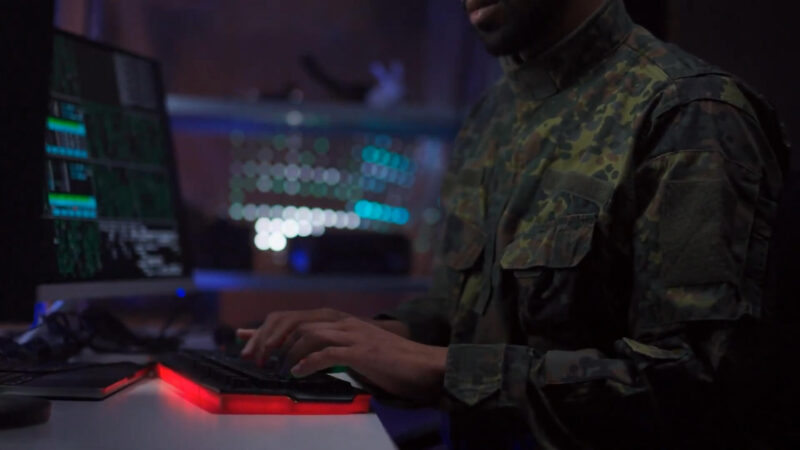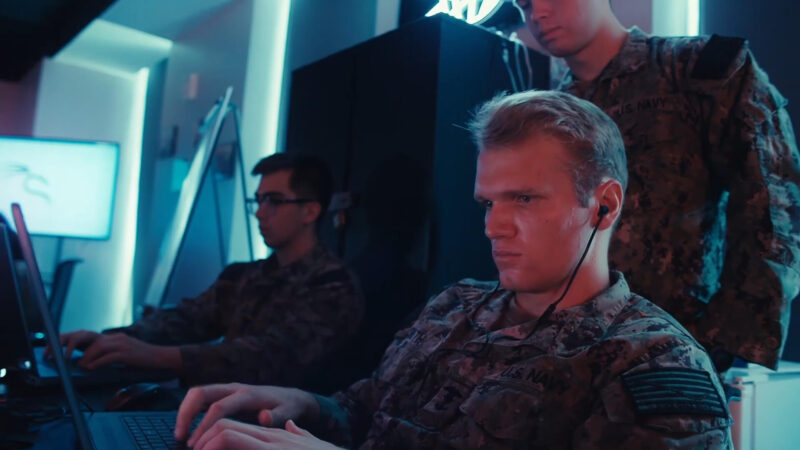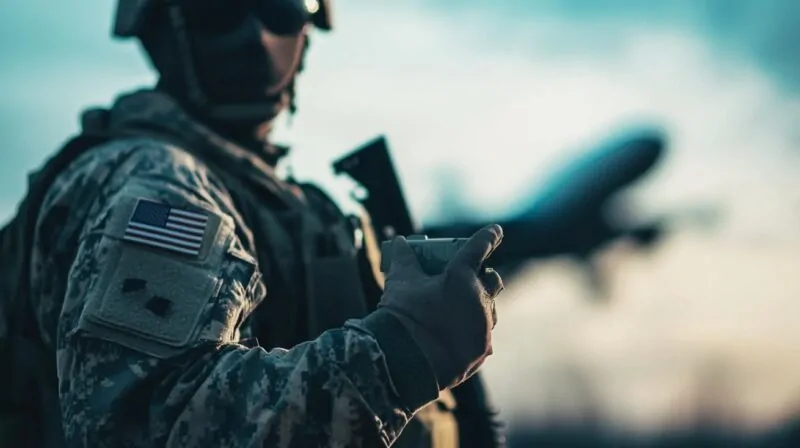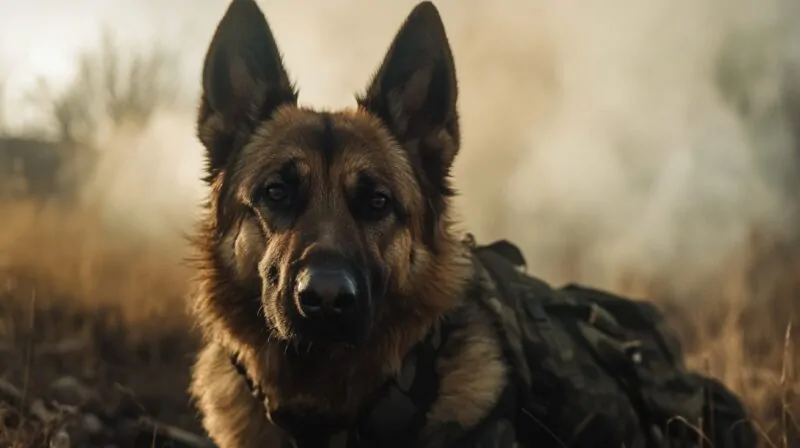Cyber warfare is now a critical element in military operations. The U.S. Air Force leads in this domain. The 1B4X1 designation represents the Air Force Specialty Code (AFSC) for Cyber Warfare Operations.
It involves both offensive and defensive cyber activities. This role includes protecting the nation’s cyberspace infrastructure and launching cyber attacks against adversaries.
Knowing what it takes to be a 1B4X1 Cyber Warfare Operator is vital for those interested in military cybersecurity.
Table of Contents
ToggleKey Takeaways
- 1B4X1 is the Air Force Specialty Code for Cyber Warfare Operations.
- Operators are involved in both offensive and defensive cyber missions.
- Training takes place at Keesler AFB and includes advanced cyber skills.
- This role is vital for protecting U.S. cyberspace and executing cyber attacks on adversaries.
- Cyber Warfare Operators are essential in modern military strategy.
How to Become a 1B4X1 Cyber Warfare Operator?
Becoming a 1B4X1 Cyber Warfare Operator in the U.S. Air Force involves a well-defined process that requires meeting specific qualifications, undergoing rigorous training, and continuously developing skills. This career path is designed to prepare airmen for the complex and demanding nature of cyber warfare.
Meeting the Initial Qualifications
- ASVAB Requirements: Candidates must achieve a minimum score in the General category of the Armed Services Vocational Aptitude Battery (ASVAB) test. A score of 70 in the Electronics (E) section is typically required to be eligible for this role.
- Security Clearance: Due to the sensitive nature of the work, candidates must be able to obtain and maintain a Top Secret security clearance. This involves a thorough background check and may take several months to complete.
- Physical and Mental Fitness: Candidates must meet the Air Force’s physical and mental fitness standards. This includes passing a medical exam and meeting the required physical fitness levels during Basic Military Training (BMT).
Basic Military Training (BMT)
All Air Force recruits begin their journey with Basic Military Training, which lasts approximately 7.5 weeks. During BMT, recruits learn the fundamentals of military life, including discipline, teamwork, physical fitness, and basic combat skills. This training lays the foundation for a successful career in the Air Force.
Technical Training at Keesler AFB
After completing BMT, recruits who are selected for the 1B4X1 specialty proceed to technical training at Keesler Air Force Base in Mississippi.
- Cybersecurity Fundamentals: Understanding the basics of cybersecurity, including network security, encryption, and the various types of cyber threats.
- Computer Systems and Networks: Learning how to manage and defend computer systems and networks, including configuring firewalls, detecting intrusions, and responding to cyber incidents.
- Cyber Law and Ethics: Understanding the legal and ethical implications of cyber warfare, including the rules of engagement and international laws governing cyber operations.
Technical training is rigorous and typically lasts around 66 classroom days. However, the duration may vary based on individual progress and additional certification requirements.
Initial Qualification Training (IQT)
Following technical training, airmen undergo Initial Qualification Training (IQT) specific to their assigned weapon systems. This phase of training can last anywhere from several months to over a year, depending on the complexity of the systems involved. IQT provides hands-on experience with the tools and techniques used in real-world cyber operations.
Role and Responsibilities of a 1B4X1 Cyber Warfare Operator
A 1B4X1 Cyber Warfare Operator in the U.S. Air Force has crucial duties focused on both defending and attacking in cyberspace. This role involves detailed and technical work that is essential to national defense.
Offensive Cyber Operations (OCO)
Cyber Warfare Operators conduct Offensive Cyber Operations (OCO) to disrupt, degrade, or destroy enemy systems. These operations target adversary networks, command systems, and critical infrastructure. For example, they might deploy cyber tools to disable enemy communications during a military operation.
Defensive Cyber Operations (DCO)
In addition to offensive actions, Cyber Warfare Operators are responsible for Defensive Cyber Operations (DCO). This includes protecting U.S. military networks from cyber threats, conducting threat hunting, and analyzing potential cyber attacks. Operators use advanced tools and techniques to prevent and respond to any intrusions into military systems.
Training Requirements for Cyber Warfare Operations
Becoming a 1B4X1 Cyber Warfare Operator requires rigorous training that equips airmen with the skills necessary to perform in this highly specialized role. The training process is designed to ensure that operators are proficient in both offensive and defensive cyber operations, as well as in the technical aspects of cybersecurity.
Basic Military Training (BMT)
The journey begins with Basic Military Training (BMT), which lasts for 7.5 weeks. During this phase, recruits are introduced to military discipline, physical fitness, and the foundational skills needed to function effectively as an airman. BMT is essential for building the discipline and resilience required for the demanding role of a Cyber Warfare Operator.
Technical Training at Keesler AFB
After BMT, airmen move on to Keesler Air Force Base (AFB) in Mississippi for their technical training. This training focuses on the core skills required for cyber warfare, including computer systems, network security, cryptography, and cyber law. The training program typically lasts around 66 classroom days, but this can vary depending on the specific needs of the trainee and the mission requirements of their unit.
- Computer Systems and Networks: Understanding the architecture, operation, and vulnerabilities of computer systems and networks is fundamental. Trainees learn about operating systems, network protocols, and how to secure these systems against cyber threats.
- Cryptography: Operators must be proficient in cryptographic techniques used to protect sensitive information. This includes both the creation and breaking of codes, which is essential for both defensive and offensive cyber operations.
- Cyber Law and Ethics: Understanding the legal and ethical implications of cyber operations is crucial. This part of the training ensures that operators are aware of the boundaries and regulations governing cyber warfare, including international laws and the rules of engagement.
Advanced Skills and Certification
Upon completion of the initial technical training, operators may be required to obtain additional certifications, such as the Information Assurance Technical Level II certification. These certifications are necessary for handling sensitive information and conducting high-level cyber operations.
Operators also undergo Initial Qualification Training (IQT), which can last from several months to over a year, depending on the complexity of the systems they will be working with. IQT includes hands-on training with real-world cyber warfare tools and techniques, ensuring that operators are ready to perform their duties in active military environments.
Offensive Cyber Operations (OCO) Explained
Offensive Cyber Operations (OCO) are a crucial part of the 1B4X1 Cyber Warfare Operator’s responsibilities. These operations involve using cyberspace as a domain to project power by applying force against adversaries. The goal is to disrupt, degrade, or destroy enemy capabilities, which can have direct and significant impacts on physical operations and infrastructure.
Objectives of Offensive Cyber Operations
The primary objective of OCO is to compromise the enemy’s cyber infrastructure to achieve military superiority. This includes targeting their communication systems, command and control structures, and even critical infrastructure like power grids and transportation networks. By doing so, OCO can weaken the adversary’s ability to wage war and support their military operations.
For example, an OCO mission might involve infiltrating an enemy’s air defense network, causing malfunctions that render their systems ineffective during an airstrike. This would provide a tactical advantage to U.S. forces by ensuring air superiority and minimizing the risk to aircraft and personnel.
Techniques and Tools Used in OCO
Cyber Warfare Operators employ a range of techniques and tools to conduct OCO.
- Malware Deployment: Operators develop and deploy malicious software to penetrate enemy systems. This malware can be designed to exfiltrate data, disrupt operations, or even cause physical damage to critical infrastructure.
- Denial of Service (DoS) Attacks: These attacks overwhelm an enemy’s network or system, rendering it unavailable for use. By disrupting communications or access to crucial systems, DoS attacks can significantly impair the enemy’s operational capabilities.
- Exploitation of Vulnerabilities: Cyber Warfare Operators are trained to identify and exploit weaknesses in enemy systems. This could involve leveraging zero-day vulnerabilities—flaws that are unknown to the software’s developer and have not yet been patched.
- Social Engineering: In some cases, OCO involves tricking individuals into revealing sensitive information or granting access to secure systems. This human-centric approach can be highly effective in bypassing technical defenses.
Integration with Military Operations
OCO is not conducted in isolation. It is closely integrated with broader military operations to enhance their effectiveness. Cyber Warfare Operators work alongside traditional military units to ensure that their actions in cyberspace align with the overall strategic objectives of a mission.
For instance, an OCO team might work with a special operations unit to disable enemy surveillance systems just before a ground assault. This coordination ensures that the physical and cyber elements of the operation are synchronized for maximum impact.
Defensive Cyber Operations (DCO) Overview
Defensive Cyber Operations (DCO) are the backbone of the 1B4X1 Cyber Warfare Operator’s role, focusing on protecting U.S. military networks and systems from cyber threats. DCO is critical to maintaining the integrity and functionality of these systems, ensuring that the military’s digital infrastructure remains secure against constant and evolving threats.
Core Objectives of Defensive Cyber Operations
The primary goal of DCO is to safeguard Department of Defense (DoD) networks and systems by detecting, mitigating, and responding to cyber threats. This includes a broad spectrum of activities designed to defend against cyber attacks, from passive defenses like firewalls to active measures such as threat hunting and incident response.
For instance, DCO involves continuously monitoring networks for signs of intrusion or abnormal activity. If a potential threat is identified, operators must quickly assess the situation, contain the threat, and take steps to neutralize it. This rapid response capability is essential to preventing breaches and minimizing damage.
Techniques and Tools Employed in DCO
- Intrusion Detection Systems (IDS): These systems monitor network traffic for suspicious activities and alert operators to potential threats. IDS can identify various types of attacks, such as unauthorized access attempts or malware infections.
- Firewalls and Anti-Virus Software: While often considered basic, these tools form the first line of defense in protecting networks from external threats. Operators configure and manage these tools to ensure they provide robust protection against known vulnerabilities.
- Threat Hunting: Unlike traditional defensive measures that react to alerts, threat hunting involves proactively searching for hidden threats within the network. Cyber Warfare Operators analyze logs, network traffic, and other data to uncover advanced persistent threats (APTs) that may evade standard detection tools.
- Incident Response: When a breach occurs, operators must execute a predefined incident response plan. This involves containing the threat, eradicating any malicious code or backdoors, and restoring normal operations. Operators also conduct post-incident analysis to prevent future occurrences.
- Forensic Analysis: After an attack, forensic analysis is conducted to understand how the attack was executed, what systems were compromised, and what data was affected. This information is crucial for improving defenses and preventing similar attacks in the future.
Coordination with Other Military Units
DCO is not only about defending individual systems but also about ensuring the overall resilience of military operations. Cyber Warfare Operators often work closely with other military units to coordinate defensive efforts. For example, during a joint operation, the cyber team might protect the communication systems of ground forces, ensuring they remain operational despite attempts to disrupt them.
Cyber Warfare Tools and Technologies
Cyber Warfare Operators in the 1B4X1 specialty use an array of advanced tools and technologies to carry out their missions. These tools are essential for both offensive and defensive operations, enabling operators to secure military networks and execute cyber attacks on enemy systems.
Offensive Tools and Technologies
In offensive operations, Cyber Warfare Operators deploy various tools designed to disrupt, degrade, or destroy enemy cyber infrastructure.
- Exploitation Frameworks: These are software platforms that allow operators to develop and execute exploits against specific vulnerabilities in enemy systems. Examples include Metasploit and Cobalt Strike, which provide frameworks for deploying payloads, establishing command and control, and maintaining persistent access to compromised systems.
- Malware and Ransomware: Custom-built malware and ransomware are often used in offensive operations to lock down enemy systems, steal sensitive data, or render critical infrastructure inoperable. These tools are designed to be stealthy, avoiding detection by standard security measures until it is too late.
- Denial of Service (DoS) Tools: These tools are used to overwhelm enemy networks with traffic, rendering them unable to function. Examples include botnets that can launch massive DoS attacks by enlisting thousands of compromised devices to flood a target system with requests, effectively shutting it down.
Defensive Tools and Technologies
On the defensive side, Cyber Warfare Operators use a range of tools to protect military networks from intrusions and attacks.
- Intrusion Detection and Prevention Systems (IDPS): These systems monitor network traffic for suspicious activities and can automatically block malicious actions. Tools like Snort and Suricata are popular examples that allow operators to detect intrusions in real time and respond immediately.
- Firewalls: Firewalls are a critical line of defense, controlling incoming and outgoing network traffic based on predetermined security rules. Modern firewalls also include advanced features like deep packet inspection, which allows them to detect and block sophisticated cyber attacks.
- Endpoint Detection and Response (EDR): EDR tools provide real-time monitoring and analysis of endpoint activities (like computers and mobile devices). These tools, such as CrowdStrike and Carbon Black, help operators identify and neutralize threats that may have bypassed initial defenses.
- Threat Intelligence Platforms: These platforms gather and analyze data from various sources to provide insights into emerging cyber threats. Tools like ThreatConnect and MISP allow Cyber Warfare Operators to stay informed about the latest attack vectors and develop strategies to defend against them.
Cryptography and Secure Communication
Cyber Warfare Operators must also be proficient in cryptographic tools and secure communication technologies. These tools are essential for both protecting sensitive information and ensuring that communication channels remain secure during operations.
- Encryption Tools: Encryption software like PGP (Pretty Good Privacy) and GPG (GNU Privacy Guard) is used to protect data at rest and in transit. These tools ensure that even if an enemy intercepts communications or data, they cannot access the contents without the decryption key.
- Virtual Private Networks (VPNs): VPNs are used to create secure tunnels over public networks, ensuring that data transmitted between locations remains confidential. Military-grade VPNs often use strong encryption protocols and multi-factor authentication to protect sensitive communications.
- Secure Messaging Platforms: Platforms like Signal and Wickr are used for encrypted communication between operators and other military personnel. These tools ensure that even if messages are intercepted, they cannot be read by unauthorized parties.
Career Path and Progression in 1B4X1
A career as a 1B4X1 Cyber Warfare Operator offers a clear path of progression with opportunities for increased responsibility, advanced training, and leadership roles. This career is structured to ensure that airmen can continuously develop their skills and advance within the Air Force.
Initial Entry and Training
The journey begins with Basic Military Training (BMT), followed by specialized technical training at Keesler Air Force Base. Upon successful completion, airmen earn the 1B431 designation, which qualifies them as entry-level Cyber Warfare Operators. At this stage, they focus on mastering the core skills required for both offensive and defensive cyber operations.
Gaining Experience and Skill Development
After initial training, airmen typically start at an operational unit where they apply their skills in real-world scenarios. As they gain experience, they may participate in more complex missions and take on additional responsibilities. This experience is crucial for advancing to higher skill levels within the 1B4X1 specialty.
Operators are encouraged to pursue additional certifications, such as Certified Information Systems Security Professional (CISSP) or Certified Ethical Hacker (CEH), to further enhance their capabilities and increase their value within the Air Force.
Advancement to 1B451 and 1B471
With sufficient experience and proven performance, operators can progress to the 1B451 level, where they take on more advanced duties, including supervising cyber operations and mentoring junior airmen. At this stage, they are expected to have a deep understanding of cyber warfare tactics and strategies, as well as the ability to lead teams in executing complex missions.
The next level, 1B471, involves even greater responsibilities. Operators at this level are often in charge of planning and coordinating large-scale cyber operations, working closely with other military branches and agencies. They may also be involved in developing new tactics, techniques, and procedures (TTPs) to enhance the effectiveness of cyber missions.
Leadership Roles and Beyond
Experienced Cyber Warfare Operators have the opportunity to move into leadership positions, such as non-commissioned officer (NCO) roles. In these positions, they oversee entire teams of operators, ensuring that missions are executed effectively and that their team members are well-trained and prepared.
Senior NCOs may also be involved in policy development, helping to shape the future of cyber warfare within the Air Force. They may work with high-level military planners to integrate cyber operations into broader military strategies, ensuring that the U.S. maintains its dominance in cyberspace.
For those who wish to continue their career beyond active duty, opportunities exist within the Air National Guard or Air Force Reserve, where they can apply their skills in a part-time capacity while pursuing civilian careers.
Challenges Faced by Cyber Warfare Operators
Cyber Warfare Operators in the 1B4X1 specialty face significant challenges that demand technical skill, quick thinking, and mental toughness. These challenges are rooted in the critical importance of their role in defending national security.
Constant Threats
Operators deal with highly skilled adversaries who are always trying to breach security systems and disrupt military operations. These threats are sophisticated and often involve state-sponsored actors using advanced tools and techniques to infiltrate and compromise military networks.
High-Stakes Decision-Making
The environment in which Cyber Warfare Operators work is high-pressure. Every action taken during an operation can have immediate and serious consequences. A wrong move can lead to critical failures, compromising sensitive military data or affecting ongoing missions. This requires operators to be extremely precise and focused at all times.
Technical Complexity
The systems and networks that operators defend are complex and require a deep understanding of technology. They must be proficient in multiple areas, including network security, cryptography, and digital forensics. This level of complexity adds to the challenges of their role, as they must constantly stay updated on the latest technologies and methods.
Cyber Warfare and Modern Military Strategy
Cyber warfare is now a crucial component of modern military strategy. The role of Cyber Warfare Operators in the 1B4X1 specialty is vital to maintaining national security in an era where battles are increasingly fought in cyberspace.
Integration with Traditional Military Operations
Cyber warfare is not an isolated domain. It is deeply integrated with traditional military operations, enhancing the effectiveness of air, land, and sea forces. Cyber Warfare Operators support these operations by disrupting enemy communications, compromising critical systems, and ensuring that U.S. forces maintain a technological advantage.
For instance, during a joint military operation, cyber warfare teams might disable an enemy’s air defense systems, allowing airstrikes to be conducted without opposition. This integration ensures that the U.S. military can operate freely and effectively in any environment.
Protection of National Infrastructure
Beyond the battlefield, Cyber Warfare Operators play a key role in protecting national infrastructure from cyber attacks. Critical infrastructure such as power grids, transportation systems, and communication networks are all potential targets for cyber warfare. Operators must ensure that these systems are secure and resilient against any potential threats.
Did you know: There are unique opportunities to participate in real-world simulations through elite programs that push the boundaries of innovation in national security
FAQs
Conclusion
1B4X1 Cyber Warfare Operators play a critical role in the modern military landscape. Their work ensures that the United States remains secure in an era where digital threats are as significant as physical ones.
These operators are at the forefront of protecting the nation’s cyberspace infrastructure and executing offensive cyber missions that can cripple adversaries’ capabilities. Their expertise in both offensive and defensive cyber operations makes them indispensable in maintaining the country’s strategic advantages in cyberspace.
Related Posts:
- Rank by Rank - Inside the US Air Force Officer Hierarchy
- Your Guide to Air Force Reserve Requirements for 2025
- A Look at US Military Helicopters: Past, Present, and Future
- Who Builds Navy Ships? A Look at the Top Shipbuilders
- Army Rangers vs Green Berets - Which Elite Force Does What?
- Inside the MQ-9 Reaper UAV - Features and Applications

